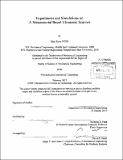| dc.contributor.advisor | Nicholas X. Fang. | en_US |
| dc.contributor.author | Hizir, Fahri Erinc | en_US |
| dc.contributor.other | Massachusetts Institute of Technology. Department of Mechanical Engineering. | en_US |
| dc.date.accessioned | 2013-06-17T19:52:33Z | |
| dc.date.available | 2013-06-17T19:52:33Z | |
| dc.date.copyright | 2013 | en_US |
| dc.date.issued | 2013 | en_US |
| dc.identifier.uri | http://hdl.handle.net/1721.1/79277 | |
| dc.description | Thesis (S.M.)--Massachusetts Institute of Technology, Dept. of Mechanical Engineering, 2013. | en_US |
| dc.description | Cataloged from PDF version of thesis. | en_US |
| dc.description | Includes bibliographical references (p. 62-65). | en_US |
| dc.description.abstract | Fingerprint scanning is one form of biometrics used to identify individuals. Ultrasonic fingerprint scanners use acoustic waves to obtain the fingerprint image and their performance is invariant to the surface conditions typically found on the finger surface due the ability of ultrasound to penetrate into sub-surfaces. This makes ultrasonic fingerprint scanning a superior technology to optical fingerprint imaging technologies [1]. In this thesis, we propose a new design of an ultrasonic fingerprint scanner, which has reduced complexity and lower cost of operation. The device uses a ID array of transducers to generate focal spots under the finger surface and to scan the pressure field scattered by the finger ridges, while obtaining images. Integration of a metamaterial layer (an array of Helmholtz resonators) under the finger surface enables imaging features smaller than the diffraction limited spot. We expect such technique to increase the image resolution of the fingerprint scanner without need for an increase in the operating frequency or power consumption. Simulation results presented in this thesis suggest that sub-wavelength acoustic focusing could be achieved over an array of Helmholtz resonators for high resolution acoustic imaging purposes. Underwater acoustic experiments performed to couple acoustic waves in the 40-60 KHz frequency range to an array of Helmholtz resonators are unsuccessful due to experimental limitations. Results of experiments involving two types of metamaterial and no metamaterial are compared. Furthermore, mathematical tools are developed which would help us better understand the propagation of acoustic signals through resonating structures. Our studies might provide quantitative information regarding resolution limits, and contribute to design guidelines for the construction of advanced metamaterial based ultrasonic imaging devices at MHz frequencies. | en_US |
| dc.description.statementofresponsibility | by Fahri Erinc Hizir. | en_US |
| dc.format.extent | 66 p. | en_US |
| dc.language.iso | eng | en_US |
| dc.publisher | Massachusetts Institute of Technology | en_US |
| dc.rights | M.I.T. theses are protected by
copyright. They may be viewed from this source for any purpose, but
reproduction or distribution in any format is prohibited without written
permission. See provided URL for inquiries about permission. | en_US |
| dc.rights.uri | http://dspace.mit.edu/handle/1721.1/7582 | en_US |
| dc.subject | Mechanical Engineering. | en_US |
| dc.title | Experiments and simulations on a metamaterial based ultrasonic scanner | en_US |
| dc.type | Thesis | en_US |
| dc.description.degree | S.M. | en_US |
| dc.contributor.department | Massachusetts Institute of Technology. Department of Mechanical Engineering | |
| dc.identifier.oclc | 846686795 | en_US |
